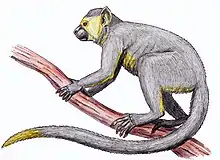Phileosimias
Phileosimias ("Eosimias ally")[2] is an extinct genus of primates with two species, P. kamli and P. bahuiorum, that are believed to be amongst the early simians.
| Phileosimias Temporal range: Early Oligocene[1] | |
|---|---|
| Scientific classification | |
| Domain: | Eukaryota |
| Kingdom: | Animalia |
| Phylum: | Chordata |
| Class: | Mammalia |
| Order: | Primates |
| Suborder: | Haplorhini |
| Infraorder: | Simiiformes |
| Family: | †Eosimiidae |
| Genus: | †Phileosimias Marivaux et al., 2005 |
| Species | |
| |
Marivaux et al. announced in 2005 their discovery of fossils of two new species, Phileosimias kamali and Phileosimias brahuiorum, found in the Bugti Hills of Pakistan. They concluded that Phileosimias are almost certainly early simians. However, they felt the fossil evidence (primarily dental specimens) was insufficient to categorise them as Eosimiidae (along with other early simians) or whether they were sufficiently different to be placed into a separate group. The shapes of their molars and premolars differ from species already classified as Eosimidae.[2]
The two species are Phileosimias brahuiorum and Phileosimias kamali, which is slightly larger, but both are estimated to have weighed about 250 grams. They were extant during the Early Oligocene epoch.[3]
| Simians/ (52) |
| ||||||||||||||||||||||||||||||||||||
| Eosimiidae |
References
- "Phileosimias". paleobiodb.org. Retrieved 2021-07-28.
- Marivaux; et al. (June 2005). "Anthropoid primates from the Oligocene of Pakistan (Bugti Hills): Data on early anthropoid evolution and biogeography". PNAS. 102 (24): 8436–41. Bibcode:2005PNAS..102.8436M. doi:10.1073/pnas.0503469102. PMC 1150860. PMID 15937103. (Full text PDF)
- Tuttle, Russell H. (17-Feb-2014). Apes and Human Evolution, Harvard. ISBN 0674073169.



